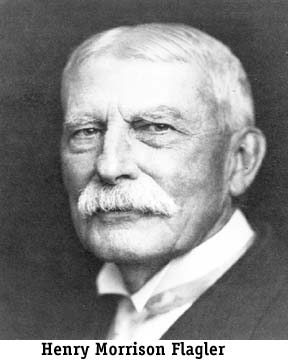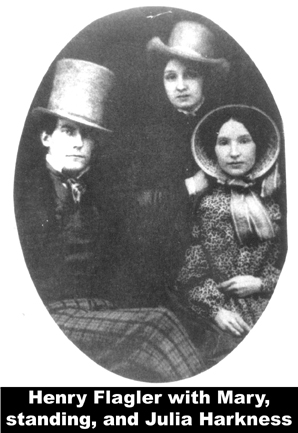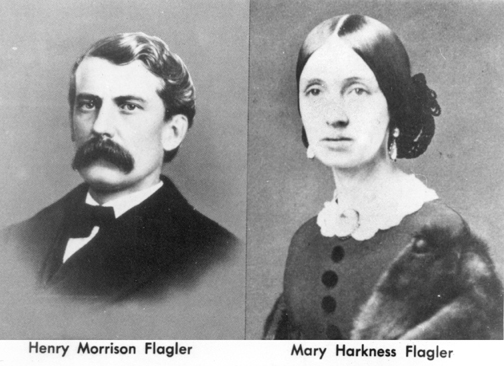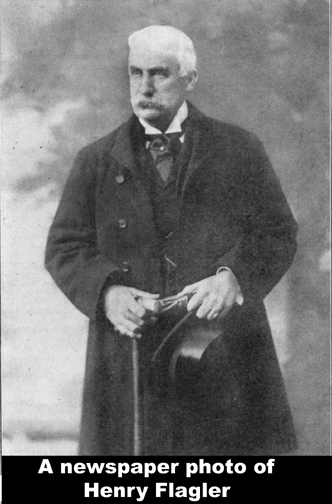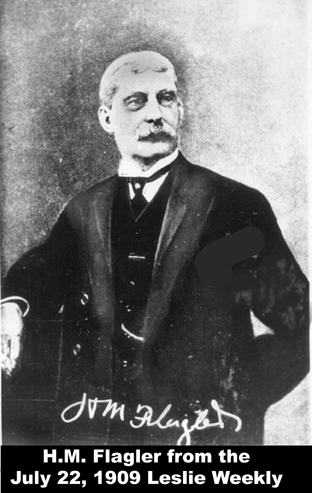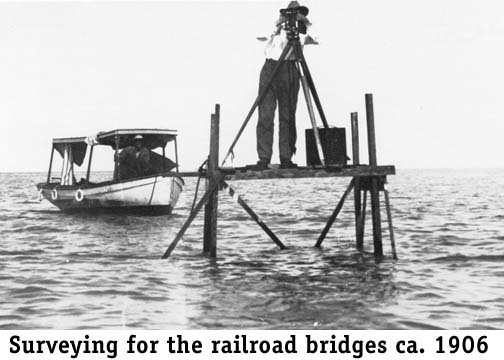|
THE RAILROAD
Railroads stemmed from early tramways that transported stone, coal and similar mined materials. These early systems were not steam driven, but pulled by animals, usually in combination with gravity. The first steam train in the United States was the "Sourbridge Lion," brought over from England by the Delaware and Hudson Canal and Railroad Company and was in operation in 1829. For a comparison, the Transcontinental Railroad was completed in 1869. On the island of Jamaica, the Jamaica Railway Company built its first complete railroad in 1843. Henry Morrison Flagler was born in Hopewell, New York on January 2, 1830, the son of a struggling Presbyterian minister. Morrison was the name of his mother's first husband (Hugh Morrison) who had died. Henry left school after the eighth grade to go work for the Harkness family in Ohio. The Harkness family was his mother's second husband's family (David Harkness) and played a helpful role in Henry's life for many years. To begin his new life, he found work on a barge traveling the newly opened Erie Canal to Lake Erie where he traveled overland to the small Harkness store in Republic, Ohio. There he began work with his half-brother, Dan Harkness.
He had arrived almost penniless. Working hard and learning all facets
of
the mercantile business, he was promoted to manager when Dan moved to a
larger store in Bellevue, Ohio, the principal hometown of the Harkness
family. After a total of five years, he then moved to Bellevue where he
bought out a partner in one of the Harkness operations with money he
had
saved. In Bellevue he courted and married his step-uncle's (Lamon Harkness) second daughter, Mary Harkness, November 9, 1853. Henry and Mary had two daughters, Jennie Louise and Carrie. Carrie died at age three. The company expanded into the grain and distillery businesses, and the latter was sold after making considerable money. One of the grain brokers he shipped grain to was John D. Rockefeller in Cleveland, Ohio. In 1862, Flagler and Barney York formed a salt producing company that boomed because of demand brought on by the Civil War. He sold his interest in the grain business to his half brother and moved to Saginaw, Michigan. When the Civil War ended in 1865, so did the huge demand for salt. The Flagler and York Salt Company went bankrupt a year later, and Flagler retained a $50,000 debt. Instead of returning to Bellevue, the Flagella's moved to Cleveland, Ohio where he re-entered the grain business and renewed his connections with John D. Rockefeller. Handsome profits from the grain business allowed him pay off his debt and to have sufficient money to invest in a new adventure. His conversations with John Rockefeller mostly involved petroleum and not grain. In 1868 at age 37, he joined with John Rockefeller and Samuel Andrews to form the Rockefeller, Andrews and Flagler Oil Refinery the RAF Refinery. - 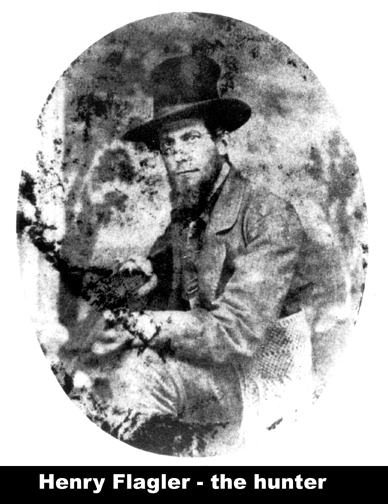 e a monopoly. Later in his life, he
was called
before
Congress for possible violations of anti-trust laws.
Also, in 1870,
Flagler's
first and only son, Harry Harness Flagler, was born. By 1884, Standard
Oil moved its headquarters to New York City, and was considered the
largest
and richest industrial company in the world. Flagler and Rockefeller
moved
to New York City in 1887, but kept their Cleveland homes. e a monopoly. Later in his life, he
was called
before
Congress for possible violations of anti-trust laws.
Also, in 1870,
Flagler's
first and only son, Harry Harness Flagler, was born. By 1884, Standard
Oil moved its headquarters to New York City, and was considered the
largest
and richest industrial company in the world. Flagler and Rockefeller
moved
to New York City in 1887, but kept their Cleveland homes.
Meanwhile, Mary had been diagnosed with tuberculosis and her health had been declining. Her doctor recommended she avoid the harsh New York winters and seek a warmer climate during the colder months. Florida was chosen for the winter of 1878 and the Flagler's set out for Jacksonville, Florida. When Flagler arrived in Jacksonville, Florida, he found the most backward state on the Atlantic Coast. Key West was Florida's largest populated city of about 10,000; Jacksonville 7,000; St. Augustine 2,300; Tampa 1,000 and Daytona 321. Miami was just a settlement, not yet a city.
In Jacksonville, Henry found few amenities for the vacationer and
was quickly bored. It could also have been the almost daily "vacation
managing"
of the rapidly growing Standard Oil Company. In 1878, lawsuits, civil
and criminal lawsuits began along with investigations. After a few
weeks Henry,
Mary
and Harry returned to New York City as Mary would not remain in Florida
without Henry. Mary's condition grew steadily worse, and she eventually
died in New York at age 48, on May 18, 1881. Young Harry was 10 years
old.
Henry had his sister, Carrie, move in and help with the care of Harry.
Jennie Louse, now married, also made frequent visits.
In 1882, under the Standard Oil Trust, Standard companies were created
in many states, With stockholder's approval Flagler became President of
Standard Oil Company of New Jersey. In spite of this, Flagler began
spending less and less time in the New York offices. - A
New Home
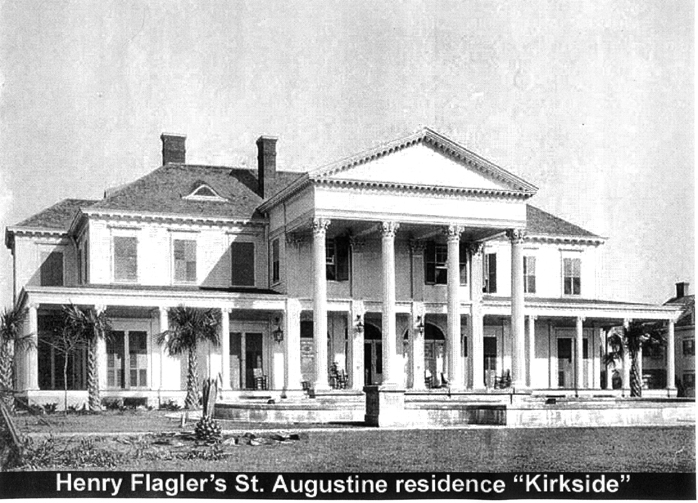 hased the third
from a competitor, renaming it the Cordova. To
make his hotels more accessible, he purchased and rebuilt a short-line
railroad company and this is how he entered the railroad
business. He
also
built in St. Augustine several churches, a hospital, waterworks,
electric
and sewer utilities, and a winter home for the family - the
Kirkside. hased the third
from a competitor, renaming it the Cordova. To
make his hotels more accessible, he purchased and rebuilt a short-line
railroad company and this is how he entered the railroad
business. He
also
built in St. Augustine several churches, a hospital, waterworks,
electric
and sewer utilities, and a winter home for the family - the
Kirkside.
It was 1885 when he purchased a short-line railroad between
Jacksonville
and St. Augustine, which was the forerunner of the Florida East Coast
Railway
(F.E.C Rwy.). He had tried to convince the previous railroad owners to
improve the system. They shook their heads "no," and their "no" proved
to be a turning point in Flagler's life and Florida's history - Flagler
needed appropriate transportation facilities. On December 1885, Flagler bought controlling stock in the 'Jacksonville, St. Augustine & Halifax River Railway,' made himself president and appointed his own general manager. Soon after he bought half of the newly formed Jacksonville, Tampa and Key West, Railway Co.
To promote better and more transportation in Florida, in 1893, the
Florida
Legislature passed a new law increasing from 3, 840 to 8,000 acres per
mile for all railroad constructed south of Daytona, Florida. Almost
immediately, Flagler created a new company, the 'Jacksonville, St.
Augustine, and Indian River Railway Company.'
He started extending his railroad lines to the south, first to Ormond
Beach,
Florida and then to Palm Beach, Florida in 1893. To support the Flagler
System, he purchased existing, or built new railroads. Again he also
built
schools, hospitals, churches, fire stations, city halls, courthouses
and
utilities. - Railroad
to Miami
Following the great Florida freezes of
December,
1894 and January and February of 1895, Julia Tuttle, the mother of
Miami, contacted Flagler through his vice-presidents, Messrs. Parrott
and Ingraham, and advised them that the region south of the New River
(Ft. Lauderdale) was untouched by the freezes.
Flagler with his
stated quest for Key West had
already considered the Key Biscayne area for expansion, but not yet
seriously - only one visit. The Model Land Company vice president,
James
Ingraham, was sent to gather details in Miami. Upon receiving
Parrott's,
Ingraham's and Tuttle's reports, Mr. Flagler asked to set up a visit to
Mrs. Tuttle. After his visit he proposed six items, the first two was
he was to be given 100 acres for a hotel and she could reserve 17 acres
of the
river and ocean property for her personal use, and he was to receive
one half of her Fort
Dallas property. This would total about 370 acres. In addition, he was
to receive one half of all her holdings between Fort Worth and Cape
Sable - these acres are not known by the author, but he does believe
this was one reason when he considered to continue his 1893 resolve to
build to Key West. First, he
surveyed a route to Cape Sable where he owned land.
Mr. Flagler also agreed to immediately
start a large hotel and build water, electric and sewer public
facilities for a new community, a contract was signed, and the railroad
reached Miami on April 15, 1896, with the first passenger train
operating into the community on the shores of Biscayne Bay on April
22. On July 28, 1896, without every having been a village or a
town or an incorporated municipality of any kind, the City of Miami
sprang into existence and over the weekend of July 26--July 28, 1896,
the FEC Railway and the City celebrated their Centennial in a grand and
gala joint event. The Royal Palm Hotel opened January 15, 1897 with 350
rooms, two electric elevators, a swimming pool, and an electric
generator for the hotel and the city.The William Brickell family owned 640 acres south of the Miami River and gave out right 320 acres to compliment the Tuttle 370 acres on the north side of the Miami River - Key West was becoming closer, but resolving the Dr. Henry Perrine grant had to be resolved. The popular story is that it took a cold winter freeze of 1894/95 and Mrs. Julia B. Tuttle to persuade him to continue to Miami. In reality it was the 8,000 acres granted from the state for each mile of railroad track he built and the gift of about 600 acres by two local families of what was to be downtown Miami that brought Flagler to Fort Dallas on April 16, 1896. Fort Dallas incorporated as Miami in July that same year. Most believe that he also had a vision of proceeding further south. A note at this time. The Flagler System denoted all of the Flagler entities, e.g. the Florida East Coast Railway (F.E.C. Rwy.) which he created in September 1895, the entire system of hotels, the land holding companies, the Florida East Coast Steamship Company created in 1897, Peninsular & Occidental (P&O) Steam Ship Company (1901) and all other subsidiaries as the Model Land Company. The overseas railroad is correctly titled the Key West Extension, Flagler System. In 1897, Flagler's second wife Ida Alice, was committed to an insane asylum in New York. Insanity was not grounds for divorce in either New York or Florida. Flagler convinced the Florida Legislature to change its law in 1901 and he married his third wife, Mary Lily Kenan, whom he had known for about eight years. As a wedding present he built the Palm Beach mansion named Whitehall. Florida later repealed this change in the divorce law . In Miami as in other places, Flagler built an electric company, water company, schools, churches, streets and homes for his workers. In 1899, he purchased three ships to transport people to and from the Bahamas where he owned two more hotels. For his ships to enter the Miami harbor he had to dredge a channel through Biscayne Bay to the docks, but it was not sufficient to be considered a deep water seaport - only nine feet deep. As years passed, the depth of the channel was slowly deepened. During the Spanish - American War, the federal government used the Tampa seaport and the Henry Plant railway, as Tampa had a deep water seaport. In 1903, the United States signed an agreement to construct the Panama Canal. Flagler envisioned Key West with its natural deep water seaport as the shipping hub for all the ships passing through the canal, connecting South and Central America, the U. S. and Cuba. His trains would thus provide land deliveries throughout the east coast. As he had been eyeing Key West for some time, these additional motivations could have been the deciding factor for Flagler to push on to Key West. Strange as it may seem, the editor of the Key West Gazette suggested a railroad linking Key West to the mainland as early as 1831. South Florida's first U.S. Senator, Stephen R. Mallory, also from Key West, while in Washington in the 1850s advocated the advantages of a Key West railroad. J. C. Baily while surveying for the International Ocean Telegraph Company in 1866 made a survey route that could be used for a railroad.
Numerous proposals were made on paper, but all lacked financing. The
National Geographical Magazine in 1896 contained an article even
mentioning
Key West's hopes centering on Henry Flagler potential. The article
"Across
the Gulf by Rail to Key West" proposed the screw pile supports used for
construction of the lighthouses for bridge supports. He was temporarily blocked from going southward by the existing approximate 36 square mile Perrine Grant. If you lay a scaled 36 mile square piece of paper on a map of south east Dade County, a south bound railroad must traverse within the boundaries of the Perrine Grant. Flagler kept attorneys assigned to assist the Dr. Henry Perrine heirs for the 36 square mile southeast land claim from Congress. The Flagler attorneys followed to Supreme Court which ruled an appropriate division of lands to the railroad, settlers, and Perrine family members in 1898. With this decision, Flagler now had his right-of-way property when and if he decided to make his move further south. It was the summer of 1902 when Flagler hired William J. Krome to survey the best route to Key West, which at that time was thought to be across the Everglades, to No Name Key and onward to Key West. They were to conduct, as we would say today, "a feasibility study" to extend the railroad to Key West. To our knowledge, he never asked anyone whether or not it would be financially successful. If you are interested in a lengthy presentation of the Cape Sable Expedition, please Click Here Krome spent the remainder of 1902 until May of 1903 surveying across the Everglades to Cape Sable. This route was deemed unadvisable. He then completed the Cutler Extension to Homestead and in early 1904, Krome was sent to survey from Homestead, across northern Key Largo and out into Hawk Channel a route to Turtle Harbor. At Turtle Harbor there was a finger passage of over 20 feet depth of water which would serve as a deep water seaport for Flagler's steamship lines. On July 6, 1904 the Turtle Harbor route was canceled and a Homestead to Key West route across Cross Key, Bahia Honda to Key West was mandated. It is not certain, and there are various versions, when the following conversation took place, if it did at all, but the aging Flagler (74 years old) called in his F.E.C. President, Joseph R. Parrott, and reportedly asked him if the railroad extension to Key West could be built. "Yes, I am sure," was the reply. Mr. Flagler in turn said, "Very well then, go ahead. Go to Key West." Supposition has it that since this happened coinciding with the US negotiations to buy the French concession to build the Panama Canal, perhaps the Panama Canal was an influence. We know and have copies of the plans approved in April 1905. The project was announced to the public in the New York Herald on June 28, 1905 and the article reprinted in the Tropical Sun. What is a fact is that Senator E. C. Crill, of Palatka, pushed through bill number 11, granting certain rights and privileges for a railroad to the F.E.C. Rwy. The act became effective May 3, 1905 and afterwards Flagler publicly announced the extension of the railroad to Key West. Regardless, this was an epic decision for the 74-year-old Flagler to make. He had practically built the east coast of Florida, had everything in life that any reasonable man could want, yet something pushed him on to new horizons. He did this with his own money, not borrowed money and there were no cutting corners to save money. About two fifths of all his Florida investments were used to complete the Key West Extension.Building the Railroad to Key West - As this would be an overseas project, Flagler purchased, leased, or built most of the heavy marine equipment in the east. Land had to be donated, purchased, or leased, as Flagler did not receive land grants in the Keys other than water passages - he did own land preciously granted to other railroad companies that he had bought. So many of the transport ships in the Atlantic were employed solely to transport supplies and materials for Flagler that it created a minor shortage for transporting other goods. It was a massive operation.
Using Krome's survey, plans were made to send advance teams ahead to
start
the more time consuming projects and the overland clearing throughout
the
Keys. Functional seaports and rail terminals had to be built at
Knight's
Key and Key West. The large bridges could not be started until huge
floating
concrete mixers could be constructed. Concrete mixer number 1 was towed
out of Miami on June 27, 1906. Work was begun throughout the Keys, not
just one huge work force moving southwest from Homestead. Over 130
acres of land was to be dredged/pumped in for the Key West Terminal.
The work camps
were, however, numbered from north to south from Homestead. Key Largo
was
camp 1 and Key West was camp 82. By the spring of 1905, construction teams were dispersed throughout the Keys. From the mainland, in April, two of the ten traveling dredges set out from what would become Florida City across Cross Key to Jewfish Creek. One dredge worked on each side of the right-of-way, piling up fill to form a track rail bed in the center. Rock was transported and spread. Tracks were laid on top of this rock foundation. The Woodall and Everglade stations were built on side tracks located where the vehicle passing lanes of the 18-mile stretch are now, now (2007) being removed for a new 3-lane highway. This was time consuming work, but not difficult. Jewfish Creek presented them with their first bridging challenge. It had to be a drawbridge to permit boat traffic even in those days also being replaced by a 65-foot fixed span bridge. The overall goal was Key West; but the intermediate goal was Knight's Key Dock. The immediate task was to lay as much track from Homestead as possible. This allowed Flagler to use his railroad mounted equipment, or "rolling stock," which could carry huge loads, make more trips and deliver directly to the place of need. The water was too shallow for larger transport ships, so they used 150 huge barges to ferry supplies to shore. The Flagler museum in Palm Beach has a lengthy collection of old newspaper clippings. They almost tell the story, and I will share some of them with you to show the progress. Unfortunately, some articles do not have the newspaper's title, but are dated. An October 28, 1905 Miami Metropolis newspaper clipping provides some indication of work: "The steamer Biscayne towed and delivered to the Keys two of the remaining double-decked houseboats [living quarters] recently completed. One of the boats will locate at Planter and the other at Matecumbe Key where camps will be established, both being under the charge of Engineer Rogers." W. P. Dusenbury was the engineer in charge of work on Key Largo. The Jewfish Creek bridge was not finished when the track arrived; however, difficulty in building a stable causeway across Lake Surprise was a greater concern. The lake was to be filled, not bridged. When fill was dumped in, it sank and disappeared. It appears that it took 15 months to construct a satisfactory fill that would support continuous trains across Lake Surprise. Labor was a constant problem. The pay was $1.25 a day with food, lodging and medical care. Along with labor, lack of fresh water and mosquitoes constantly haunted the project. It is said that a total of 40,000 men, but never over 5,000 at any one time, were employed. An average of 4.5 million gallons of fresh water was required each month. An unidentified clipping dated June 27, 1906: "Concrete Mixer No. 1 was hauled out from the north end of the (Miami) terminal dock, and towed to its destination in the Keys by the steamer Columbia. This is an indication that the arch and bridgework is soon to begin. Mixer No. 2 is about ready [for delivery]." -----CONTINUED-----
|
